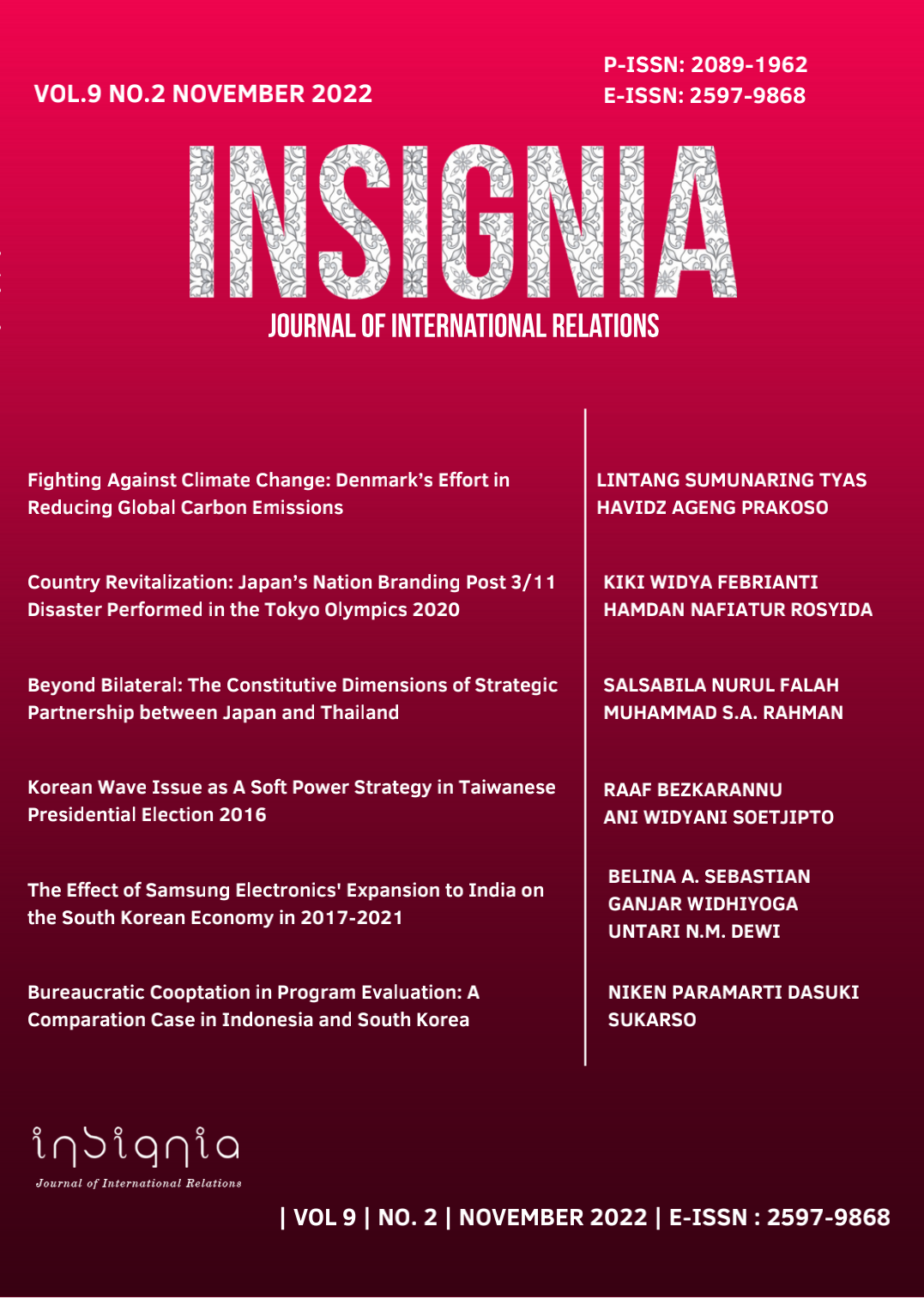The Effect of Samsung Electronics' Expansion to India on the South Korean Economy in 2017-2021
Abstract
Samsung is the largest multinational company in South Korea that has successfully expanded to various countries. India is the second largest technology market after China which is a new market in the Asian continent. Currently, India is being targeted by many world technology companies to market their products in the South Asian region, so this is an opportunity for Samsung to enter and expand in India. Samsung, which has successfully entered India, is always innovating in creating and developing pre-owned technology products to increase sales of its products. This also affects the South Korean economy, where with the expansion carried out by Samsung, the South Korean economy has experienced significant growth in terms of the increase in GDP every year which is the focus of this research. This study uses quantitative methods with descriptive statistical analysis methods by providing additional data in the form of graphs. Samsung's successful expansion to India is marked by investments in the construction of new manufacturing plants in the Noida area, Uttar-Pradesh, and sales of Samsung products in India are the second largest with average avenue is 700 billion INR. These results also affect the economic position of South Korea so that it becomes a country that has a fairly strong position in the field of technological development. The conclusion of this study is that Samsung brought South Korea to be part of the category of developed countries in the world with significant GDP growth every year from the period 2017-2021.
References
Armstrong-Williams, D. (2018). South Korea as a middle power: The growing globalization of South Korean foreign policy in the 1990s. In Robert Compton, Transforming East Asian Domestic and International Politics: The Impact of Economy and Globalization. London: Routledge. https://doi.org/10.4324/9781138741508
Held, D. (2004). A Globalizing World? Culture, Economics, Politics. London: Routledge.
Jackson, J., & McIver, R. (2001). Macroeconomics. New South Wales.
Mankiw, N. G. (2006). Teori Makroekonomi 6th Edition, Terjemahan Nurmawan. Jakarta: Erlangga.
McConnell, C. R., Brue, S. L. & Flynn, S. M. (2008). Macroeconomics: principles, problems, and policies. New York: McGraw-Hill Irwin.
Perry-Globa, P., Weeks, P., Zelinski, V., Yoshida, D., & Colyer, J. (2007). Perspectives on Globalization. Oxford: Oxford University Press.
Steger, M. B. (2009). Globalization: A brief insight. New York: Sterling.
Sugiyono. (2015). Metode Penelitian Kuantitatif, Kualitatif, dan Penelitian dan Pengembangan. Bandung.
Waters, M. (1995). Globalization 2nd Edition. London: Routledge.
Journals
Chang, S. I. (2012). Study on human resource management in Korea’s chaebol enterprise: A case study of Samsung Electronics. International Journal of Human Resource Management, 23(7), 1436-1461. https://doi.org/10.1080/09585192.2011.579922
Endrodi-Kovács, V., Kutasi, G., & Magasházi, A. (2018). Visegrád group expertise and position in the Samsung global value chain: A case study of Samsung Electronics in the V4 countries. Central European Business Review, 7(1), 14-36.
Kim, J. (2011). Foreign aid and economic development: The success story of South Korea. Pacific Focus, 26(2), 260-286. https://doi.org/10.1111/j.1976-5118.2011.01065.x
Martell, L. (2007). The Third wave in globalization theory. International Studies Review, 9(2), 173-196.
Schmid, A. (2012). A History of Korea: From Antiquity to the Present. By Michael J. Seth. Rowman and Littlefield, 2011. xi, 573 pp. $70.00 (cloth); $34.95 (paper). - A Concise History of Modern Korea: From the Late Nineteenth Century to the Present. By Michael J. Seth. Rowman and Littlefield, 2011. vii, 295pp. $90.00 (cloth); $30.95 (paper). The Journal of Asian Studies, 71(1), 278-279. https://doi.org/10.1017/s0021911811002774
Shrey, J., & Amrit, D. (2018). South Korea’s Economy After the Korean War. International Journal of Advance Research and Development, 3(1), 175-177.
Solakoglu, O. (2016). Three Different Perspectives On The Role Of The Nation-State In Today’s Globalized World. European Scientific Journal, 12(10), 1-8.
Suh, J. Y., & Kim, Y. J. (2009). Logistics lean integration strategies: case study of Samsung Electronics LCD inbound logistics. Journal of International Logistics and Trade, 7(1), 107-116. https://doi.org/10.24006/jilt.2009.7.1.107
Warman, Casey. (2013). The Portability of New Immigrants’ Human Capital: Language, Education, and Occupational Skills. Canadian Public Policy, 14(I), 64-79.
Article: Online
Andolfatto, P. (2005). “Macroeconomic Theory and Policy.” MPRA Paper No. 6403. Accessed from https://mpra.ub.uni-muenchen.de/6403/1/MPRA_paper_6403.pdf.
Britannica. (2022). “Samsung: South Korea Company.” Accessed from https://www.britannica.com/topic/Samsung-Electronics.
Crunchbase. (2020). “Samsung Electronics.” Accessed from https://www.crunchbase.com/organization/samsung-electronics.
India Times. (2022). “Samsung leads premium smartphone market in India with 38% share in March 2020: Report.” Accessed from https://timesofindia.indiatimes.com/gadgets-news/samsung-leads-premium-smartphone-market-in-india-with-38-market-share-in-march-2022-report/articleshow/91442105.cms
Muchhal, Jitendra. (2018). “How Samsung came to India in 1995!.” Accessed from https://www.linkedin.com/pulse/how-samsung-came-india-1995-jitendra-muchhal/.
Samsung Newsroom India. (2018, July 9). “Samsung Inaugurates World’s Largest Mobile Factory in India; Honourable Prime Minister Shri Narendra Modi Flags-off ‘Make for the World’.” Accessed from https://news.samsung.com/in/samsung-inaugurates-worlds-largest-mobile-factory-in-india.
Samsung Newsroom. (2012). “History of Samsung (8): RAM Grows as Tape Recorders Shrink, Awards Pile Up: 1986-87.” Accessed from https://news.samsung.com/global/15127.
Samsung. (2020). “Samsung Reiterates Commitment to India with New Vision #PoweringDigitalIndia.” Accessed from https://www.samsung.com/global/business/networks/insights/press-release/1210-samsung-reiterates-commitment-to-india-with-new-vision-poweringdigitalindia/.
Statista. (2022). “India net sales revenue of samsung corporation.” Accessed from https://www.statista.com/statistics/719510/india-net-sales-revenue-of-samsung-corporation/.
USC Public Diplomacy. (2014). “Ecolution Koreas Public Diplomacy.” Accessed from https://uscpublicdiplomacy.org/blog/evolution-koreas-public-diplomacy

This work is licensed under a Creative Commons Attribution-NonCommercial-ShareAlike 4.0 International License.
1. The author retains copyright and grants the journal the right of first publication with the work simultaneously licensed under a Creative Commons attribution license that allows others to share the work within an acknowledgment of the work’s authorship and initial publication of this journal.
3. Authors are permitted and encouraged to post their work online (e.g., in institutional repositories or on their websites) before and during submission, as it can lead to productive exchanges and earlier and more extraordinary citations of published works.


.png)


